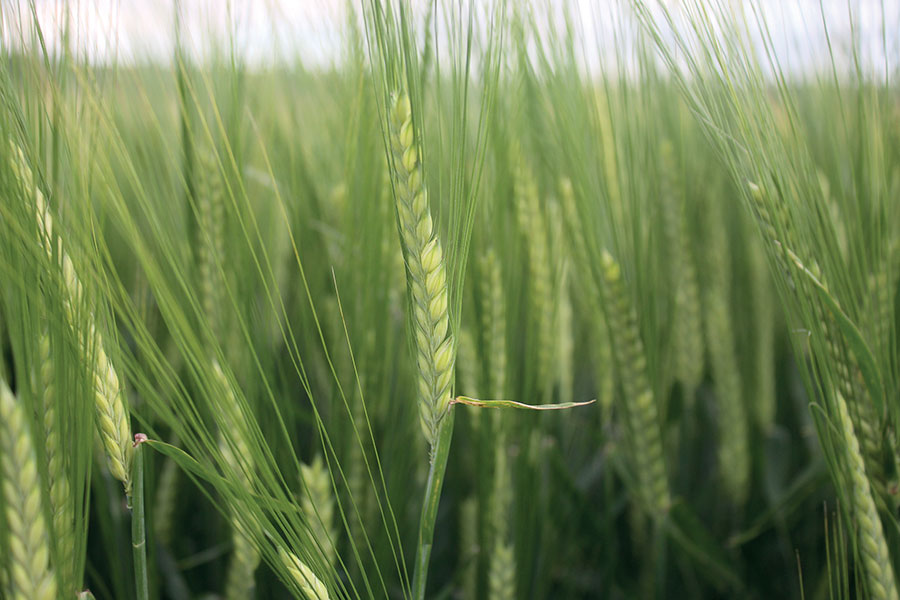How to maximise spring barley this season
24th May 2024
An unusually wet spring meant there was very little spring barley in the ground by mid-April, when a press briefing saw experts share top tips on maximising the crop – as well as a new barley resource for growers and agronomists. Sarah Kidby reports.

In a condensed season such as this, attention to detail is important for maximising the crop – and spring barley is one that responds very well to detail, explained BASF business development manager, David Leahy. Speaking during a press briefing to launch the new Barley Agronomy Guide, he noted that seeding rates become much more important in a late season and may be increased this year. As the season gets later, the crop’s ability to tiller as it would have done earlier is reduced.
Crop nutrition is absolutely vital, and there are strong arguments for putting 75–80%, or up to 100% of the nitrogen into the seedbed this year. “Again, that’s down to the fact that the season is condensed and the risk with top dressing nitrogen at that tillering stage. It might sit on top of the ground, particularly if we have a period of drought,” Mr Leahy explained.
Trace element deficiencies are another issue the later the season goes, and barley responds very well to early crop nutrition, he said. But despite these challenges, one of the big advantages of a delayed drilling window is the opportunity to get on top of grassweeds.
Disease control
Rhynchosporium pressure is largely dictated by what happens when the crop develops from tillering onwards. Timings from the key end of tillering to early stem extension are still crucial, and ramularia has to be a focus from the word go, Mr Leahy reckons. “We know that it’s a disease which is largely exasperated by stress. As barley is racing through those growth stages, stress does become a factor and we do have to be mindful of every application we do, that we don’t knock the crop.” Net blotch has also raised its head in the last few years.
Stephen Kildea, a researcher at Teagasc, the Irish Agriculture and Food Development Authority, agreed that since the loss of chlorothalonil four years ago, ramularia has become a key concern late in the season, and a more challenging disease to control. It can also quickly develop fungicide resistance. Getting the basics right is important for control, taking into account the rotation, sowing date and most of all variety. And if you’re seeing signs of the disease, it’s probably too late, he added.

The later the season, the less the disease pressure; however, a disadvantage of late drilling is barley yellow dwarf virus. “Getting out with insecticides early in the season, certainly at that two-leaf stage will become pretty important as the season progresses. That’s largely driven by your location,” Mr Leahy advised.
Understanding where the inoculum is coming from is key. Rhynchosporium, net blotch, nodorum, rust and mildew will be trash borne from previous crops, but there is potentially a seed-borne component to ramularia, Dr Kildea noted. Equally, for rhychosporium and net blotch it’s probably a major source of inoculum. When the Mlo resistance gene is in the variety and working well, mildew is a lower risk, but rust is appearing more in spring barley, coming through from the end of June into the start of July.
Research by the EuroBarley group trialled a range of chemistries and while there were some differences between the products, they found the SDHIs and some of the QoIs provided very good disease control. From a rust perspective, products including Elatus ERA, Xemium, Fandango, Revytrex, Priaxor, Revystar, all provided very high levels of control. While there were fewer trials for net blotch, very good efficacy levels were seen.
Meanwhile, net blotch trials conducted in Ireland last year indicated some SDHI resistance, though there was some efficacy from Imtrex and Proline when applied at GS30 and 49 at half label rate. Modem, on the other hand, provided very good efficacy.
PGR applications
Speaking at the time of the briefing in late April, Mr Leahy noted that many earlier PGR applications had been missed, and growers were looking at applications at growth stage 33 onward. “Rooting could become an issue with winter barley, particularly if we hit a period of drought, but purely from a spring barley perspective, PGR choice is largely driven by variety, but equally the density of the canopy.” PGRs can be quite hard on barley crops, particularly in periods of drought, he warned.
Lodging risk

Despite a lot of attention on lodging in winter wheat and winter barley, spring barley is actually one of the worst culprits, said ADAS crop physiologist, Pete Berry. A lot of varieties are now quite weak – 12 out of 18 varieties on the Recommended List have a lodging resistance score of 7 or less out of 9 – Dr Berry recommends a target of 8. Additionally, many of the strategies to maximise barley yield also increase the lodging risk, for example, increasing the seed rate earlier and applying more nitrogen.
With later drilling this year, he believes there’s a lower risk of lodging for spring barley – wet weather has reduced soil residual nitrogen levels and some crops will have been established in less-than-perfect seed beds, which should reduce the plant population. However, there will be crops what were established in quite warm soils, and farmers and agronomists could be tempted to push seed rates up and increase the amount of nitrogen applied to the seedbed.
Dr Berry warned: “I think it’s often not fully recognised the severity of yield losses that could occur if you get early lodging, i.e. at flowering. You can lose half your yield. And then you’ve got brackling on top of that as well. […] We’ve seen yield losses of over 1t/ha just from brackling. And then you’ve got the cost, of course, of drying and extra combining time.”
It’s often thought that stem lodging is a bigger issue for barley, but in fact it’s root lodging, especially in crops that lodge early. As the crop matures, stem lodging becomes more likely because the strength of the stem halves between flowering and harvest.
Improving lodging resistance
ADAS research has shown that reducing the seed rate by 50 seeds/m2 increases the variety lodging resistance score by one point for root lodging and three quarters of a point for stem lodging. “That’s not a massive decrease in seeds/m2, but it’s having a big impact on the root and stem lodging risk,” Dr Berry explained.
Decreasing the nitrogen rate also increases the lodging resistance score by 0.3 points for root lodging, and 0.6 points for stem lodging. And the timing of application is key.
“We’ve found that if you put on all the N in the seedbed, and you’ve already got quite a high soil residual N, that will increase the lodging risk. Shifting some of the nitrogen from the seedbed to a bit later, after the crop has started to emerge and during early tillering, can help to reduce the lodging risk,” he said.
As a rule of thumb, reducing the nitrogen rate from 30kg of N per hectare from that recommended by BB 209, would reduce yield by about 0.2 tonnes per hectare, he advises. As an example, a variety with a lodging resistance score of six without a PGR could gain 2–3 lodging resistance points through the measures recommended. Reducing the seed rate by 50 seeds/m2, reducing its N rate by 30kg N/ha and using a PGR that reduces height by about 8cm, would pull up lodging resistance score up to eight or nine.
Identifying lodging risk
The crop’s risk of lodging can be determined by the size of its canopy at GS30. “We want the crops to have a large canopy at growth stage 30, we want them to have lots of shoots, but we also want to identify those crops which have got those sorts of canopies, recognise that they’ve got a high lodging risk and then do something about it with our lodging management strategy,” Dr Berry explained.
Estimating canopy size is important and the most accurate method is counting the number of shoots per m2. It’s also important to remember that around the cut-off date for the last PGR application, which could be between GS39 and 45 depending on the PGR, the crop has only reached half its final height. In a year with a dry spring, lodging risk could appear very low at GS39 – and there may be concerns over stressing the crop with the PGR – but if there is then a wet period, the crop still has half its height to come and may end up producing a tall, lodging-prone crop.
“My mantra is really to mix actives and split applications where possible to maximise efficacy of your PGR,” he said. “This season it will be even more of a challenge because the crop is going to race through its growth stages. There will be a pretty short window for applying a PGR, and it might not be possible to apply more than one. Farmers and agronomists need to be really on it to make sure they get it applied at the right time.”
New resource
BASF, together with ADAS, NIAB and SRUC, have launched a new barley guide, which is intended to be a ‘one stop shop’ for growers and agronomists. It offers information on everything from seeding rates to establishment methods to disease control to PGR choices. It covers everything from the day you put the seed in the ground up to spraying. Read the guide online.
Read more arable news



